+447709283333 | info@damavandpro.com

How To Grow Lupines
Once you’ve experienced the enchantment of nurturing Lupines, you’re bound to become a lifelong aficionado. Revel in the mesmerizing hues of tightly clustered flower spikes, while the intricate palmate leaves add a captivating dimension to any garden landscape.
These resilient beauties not only fend off deer but also lend themselves splendidly to low-maintenance meadows or the quaint charm of a cottage-style garden. Drawing in a kaleidoscope of bees and butterflies with their vibrant, multi-toned blooms, Lupines are a beacon for pollinator enthusiasts.
How To Grow Lupines
Beyond their ornamental allure, Lupines play a vital role as legumes, actively enriching the soil by fixing nitrogen and promoting overall soil health. Strategically integrating Lupines into your garden can foster a thriving ecosystem, boosting soil fertility and sustaining long-term vitality.
Lupine Life Cycles
Annual Lupines, such as the iconic Texas Bluebonnets and Arroyo Lupines, undergo a single-year lifecycle. In regions with favorable conditions, they may self-sow in warmer climates. However, in colder environments where plants cannot survive winter, annual reseeding is optimal.
In contrast, Perennial Lupines like the enduring Russell Lupine, boast perennial status, ensuring their return year after year from their resilient root systems.
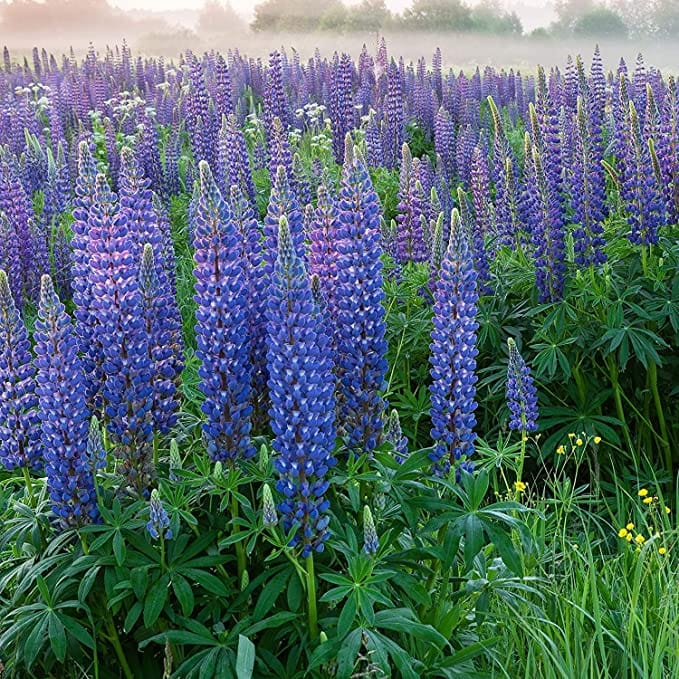
Finding the Perfect Place for Lupines
Lupines thrive in sunny locations with well-drained soil. Let’s explore the ideal planting conditions for these vibrant flowers:
Sunshine & Drainage:
- Look for a sunny spot in your garden with good drainage. Lupines love sunshine but don’t mind some afternoon shade in hot climates.
- Well-drained soil is essential! They won’t tolerate soggy conditions.
Soil Acidity:
- Lupines prefer slightly acidic soil. If your soil is very alkaline, consider amending it before planting.
- Russell hybrids (L. polyphyllus) are more tolerant of moist conditions than other lupine varieties.
Planting Distance:
- When sowing seeds, spread them at a rate of about 1 pound per 1000 square feet.
- For established plants, space larger varieties 2-3 feet apart and smaller varieties 12-18 inches apart.
Seeding vs. Plants:
- Lupines come in both annual and perennial varieties.
- Seeds can produce both annual and perennial plants, but the resulting flowers may not match the original color. Seeds often revert to blue-violet or white tones.
- Potted lupines are typically perennial cultivars, meaning they’ll come back year after year.
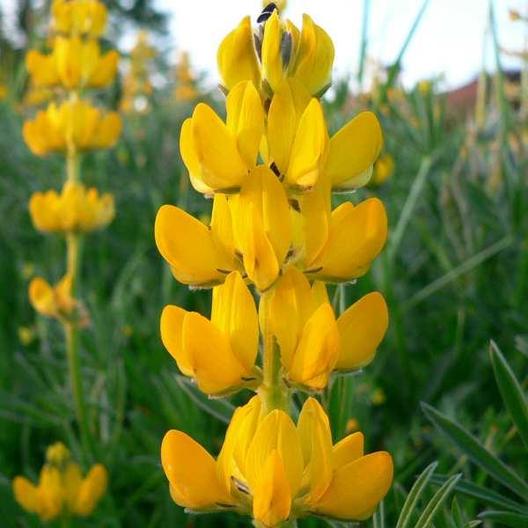
Tips For Growing Lupine Plants
Upon receipt in early spring, promptly plant them in a hole enriched with organic matter and grit to ensure proper drainage.
Avoid mulching directly around the plant’s base to prevent potential rot.
Water thoroughly after planting.
Guidelines For Sowing Lupine Seeds
Due to their sturdy seed coat, consider soaking seeds for 24-48 hours or gently roughening them with sandpaper before planting.
While Lupine seeds can be sown in early spring, they often fare better when planted later in the season, allowing them to overwinter and bloom the following spring.
Ensure good soil-to-seed contact by firmly pressing the seeds into the soil. Keep the soil moist, especially if the weather is dry, until germination occurs, which may take up to 10 days.
Growing Lupins in Pots or Ground: Your Planting Options
Lupins are versatile plants that can thrive in both pots and directly in the ground. Here’s a breakdown of both methods to help you decide what’s best for you:
Planting Lupins in Pots:
- Perfect for Limited Space: Ideal for balconies, patios, or smaller gardens.
- Choose the Right Pot: Select a deep container with good drainage.
- Enjoy Portability: Easily relocate your lupins to different spots for optimal sun exposure.
Planting Lupins in the Ground:
- More Room for Growth: Allows for larger, bushier plants.
- Winter Considerations: In colder climates, ensure your chosen location offers adequate winter protection for the roots.
- Less Maintenance: Established lupins in the ground are generally less maintenance compared to potted lupins.
Can I Plant Lupin Seeds Straight into the Ground?
Yes! You can definitely plant lupin seeds directly in your garden. However, the ideal timing for this will depend on your climate. Here are some general guidelines:
- Early Spring Planting: Recommended in mild climates with cool springs. Seeds will germinate and establish before hot weather arrives.
- Late Fall Planting: Suitable for colder regions with harsh winters. Seeds will germinate in the spring as the weather warms.
Note: Whichever planting method you choose, ensure you follow proper seed preparation and sowing techniques for optimal germination and growth.
-

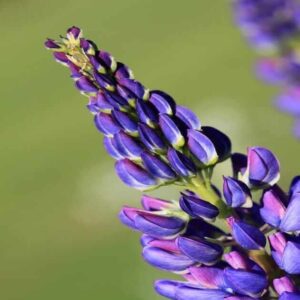
1kg Blue Lupine Organic Seeds Wildflower Garden
£25.00 -
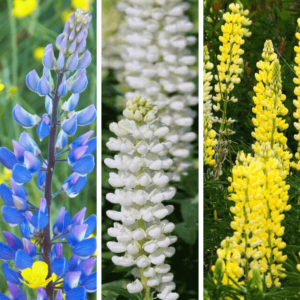
Lupine Seed Mix, Lupinus | DamavandPro Seeds
£29.99 -
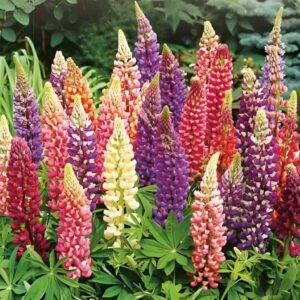
RUSSELL LUPINE SEED MIX: LUPINE RUSSELL HYBRID
£12.00 – £99.00Buy Now This product has multiple variants. The options may be chosen on the product page
Lupine Love All Year Round
Lupines are stunning spring bloomers, but keeping them happy throughout the seasons takes a little TLC. Here’s your guide to lupine success:
Springtime Stars:
- Sunshine Seekers: These beauties love cool weather and sunshine. Not big fans of heat or humidity, so keep that in mind for your climate.
- Shape & Size: Lupines grow in a round form, reaching 1-4 feet tall depending on the variety. Their flowers resemble peas, packed on tall stalks.
Standing Tall (Optional):
Most lupines stand strong on their own. But for tall Russell lupines in windy areas, staking their flower spikes for extra support is a good idea.
Watering Wisely:
- Young & Thirsty: When young, lupines need consistent watering to help their roots grow deep. Let the soil dry a bit between drinks.
- Grown & Drought-Tolerant: Once mature, they only need water during dry spells or extended hot periods.
Feed Me (Maybe):
Lupines don’t need extra fertilizer. However, a sprinkle of compost (keep it away from the base) helps replenish nutrients.
Blooming Again (Possibly):
If you deadhead (remove spent flowers) quickly, lupines might give you a lighter second bloom on side shoots. But if seeds form first, a repeat performance is unlikely.
End of Season Care:
- Don’t Divide: Lupines have deep roots and dislike being moved, so dividing them isn’t recommended.
- Pests & Problems: Watch out for powdery mildew in hot, humid conditions. Pill bugs (sow bugs) might munch on seeds and seedlings.
Important Note:
Lupine seeds are food crops in some areas, but avoid using them for culinary purposes in your own garden.
Lupine’s Best Buddies: Companion Planting Guide
Lupines can be dazzling soloists, but they also play well with others! Here are some fantastic companion plants for your lupines:
Wildflower Friends:
- California Poppy (native): A vibrant burst of color alongside lupines in a spring meadow.
- Indian Paintbrush (native): Native beauty that complements lupines in a natural setting.
- Cheerful and classic companions for lupines in a wildflower display.
Springtime Spectacle:
- Tulips: Plant tulips in fall, then sow lupine seeds on top. As tulips bloom early, lupine foliage creates a backdrop. Once tulips finish, lupines take center stage!
Perennial Powerhouses:
- Peonies: Lush blooms that share a late spring/early summer bloom time with lupines.
- Bearded Irises: Striking companions for lupines, adding another layer of color and texture to your garden.
Have you grown lupines in your garden? We’d love to hear about your experiences and any tips you have for other gardeners. Please share your thoughts in the comments below or connect with us on our social media channels. Happy gardening!

This article is a great resource for anyone wanting to grow lupines! It clearly covers all the essentials from sunlight and soil conditions to planting tips and seed care. I especially appreciate the advice on encouraging blooms and the pros and cons of starting from seed versus transplanting. Following this guide will surely lead to a beautiful display of lupines in your garden.
The blog post on growing lupines is informative and well-organized. It covers essential aspects of lupine cultivation, making it easy for beginners to follow. I appreciate the clear instructions on planting, care, and propagation. The use of visuals and step-by-step guidance enhances the overall experience. Keep up the great work! 🌱🌸